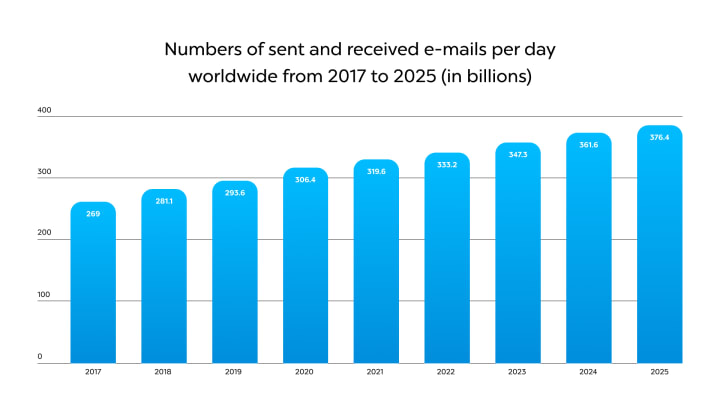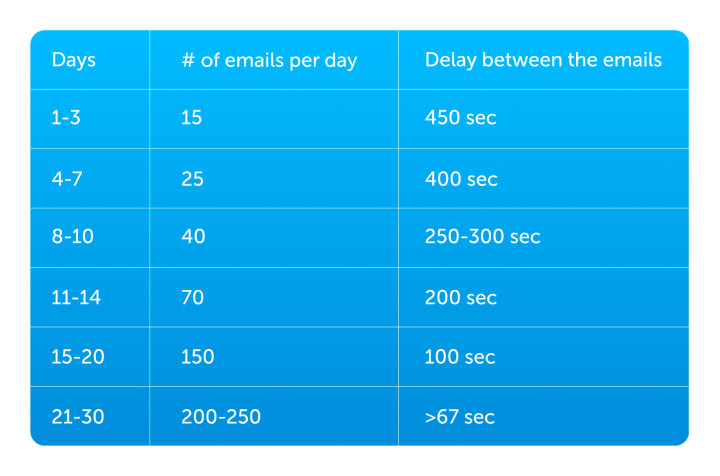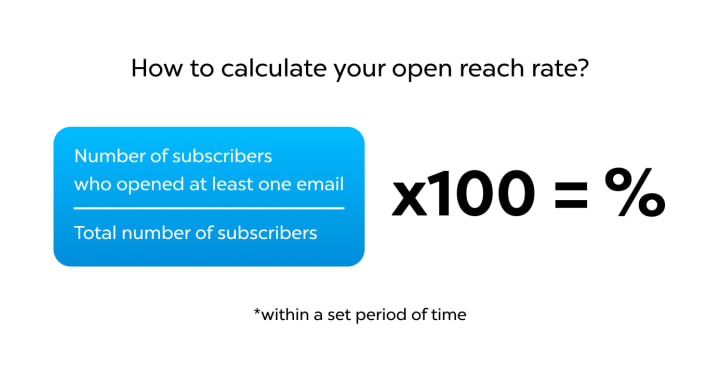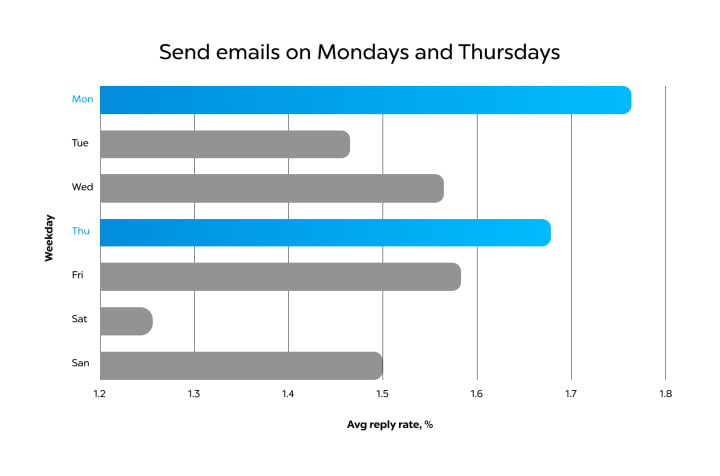
No one doubts that email campaigns are a powerful marketing tool. Every day, 4 billion people check their inboxes and read their emails. The ROI for email campaigns can reach 3600% in some cases, making it one of the most effective acquisition channels.

Email campaigns are a hot topic among marketers, but the importance of deliverability rates is often overlooked. Without a high deliverability rate, recipients won't receive the email and won't convert, resulting in lost profit. How can someone make a purchase if they don't even receive the promotion information via email?
We have good news: you can influence the deliverability of emails. The most important thing is to maintain the reputation of your domain to ensure that your emails do not end up in the spam folder. If you have no problems with this, you don’t have to worry about the rest. In the post, we will discuss 9 main rules that you should follow.
1. Set up your email correctly
Statistics show that 45% of emails sent worldwide are nothing more than spam. And 90% of cyber attacks happen through email. These are compelling reasons to demand correct settings and authentication from email senders, which is what email marketing services do to protect their users.
For beginners, setting up infrastructure may seem too complicated, and they skip this step or do it thoughtlessly. This is a bad idea. First, create a domain (@yourbusiness.com) and several subdomains (@yourbusinessteam.com). Do not use free email services (such as Gmail or Outlook) if you plan to launch mass mailing.
Pay attention to the authenticity of the email domain. This is necessary to be sure of reliability and security. Study and use the SPF, DKIM, DMARC, and BIMI protocols. If you cannot set up email yourself, seek the help of a specialist. This is important because otherwise, there is a risk that most of your emails will not pass moderation and will not be delivered to recipients.
2. Gradually warm up your domain
Once you have successfully completed the settings, start “warming up” your domain. Gradually increase the number of emails you send to avoid raising suspicion with your email provider and causing negative reactions from recipients. Be patient, soon you will be able to send out millions of emails.
Pay attention to the content of the email. It should catch the recipient’s attention. At this stage, it is essential that as many emails as possible are opened. The success indicator will be the recipient’s response to the email or a mark that the email is important to them.

Warming up the domain takes about a month. This can be done manually or with the help of specialized services, which is much more convenient and faster.
3. Choose metrics consciously
A warmed-up domain is ready for mass mailing. But the work of a marketer does not end there. To understand if everything is working correctly, properly selected metrics will help. If there are any deviations, the settings need to be adjusted.
There are many performance indicators in marketing, and sometimes it can be difficult to determine which one to focus on. One of the most common metrics used in email marketing is the Open Rate. This is the ratio that shows the percentage of opened emails out of the delivered ones.
Another metric is the Open reach, which shows the number of unique recipients who opened the sent messages during a certain period of time.

The Placement rate is a metric that counts the total number of delivered emails (including those in the spam folder). This metric is very similar to the deliverability rate, with the only difference — the deliverability rate counts emails that landed in the inbox and does not take into account those that ended up in spam.
Each business chooses key metrics on which to focus its efforts. These indicators allow you to take a closer look at the real state of affairs in the company, and assess the effectiveness of advertising campaigns. With their help, you can notice which actions bring the highest result in customer engagement and how to influence deliverability.
4. Adapt email campaigns for mobile devices
Your email only has three seconds to live if the recipient tries to open it on their mobile phone and it doesn’t open correctly or doesn’t open at all. Unoptimized emails are deleted by 70% of people, without even attempting to open them on their computer. 15% of those people will also unsubscribe from the mailing list. No matter how you slice it, people check their email on mobile phones much more frequently than on desktops.
If you don’t optimize your email campaigns for mobile devices, you’ll lose a significant portion of your audience and potential revenue. Follow these simple rules. Make sure the email subject line is concise and no more than 30 characters, use clear and prominent calls-to-action (CTAs), and include preheaders to entice recipients to open your emails.
Monitor your reputation: every unsubscribed recipient negatively impacts it. Indirectly, this leads to a decrease in deliverability.
5. Carefully manage your contact list
A high-quality mailing list is a clean one. Of course, it’s important to increase the number of contacts, but it’s also useful to remove fake addresses and inactive users. According to statistics, the number of “live” recipients in the database decreases by a quarter every year. Regularly clean up your database, as this is key to a good domain reputation and a significant bonus for email deliverability.
Keep in mind that 20% of customers make mistakes and typos in their email addresses. Some do it intentionally, while others don’t. Continuously check your list for new contacts, remove non-existent and non-working addresses. The right decision is to exclude from the database those to whom emails are often undelivered. There is no benefit from them, only harm to your company’s reputation.
Using a purchased database is the most direct and fastest way to permanently damage the sender’s reputation, along with its deliverability. Marketers still fall for this method of rapidly increasing their contact list. However, purchased databases are highly unreliable: no one knows for sure how many fake contacts they contain. And there is no guarantee that a fresh audience will be interested in your product.
6. Segment your audience and personalize your emails
Segmentation and personalization are the main marketing tools for successful campaigns. Segmenting your subscriber list can increase email campaign revenue by 760%.
Personalization increases user engagement. It has been observed that 88% of recipients are more likely to open and read emails with personalized elements.
Together, these two techniques work great. Divide all subscribers into groups based on selected significant criteria. For each group, you can develop unique content that is most suitable for users’ needs and preferences.
7. Make the unsubscribe process as simple as possible
Many people think that making the process of unsubscribing from a mailing list complicated will keep customers and save the company from losing its audience. In fact, it’s quite the opposite. When a person has made the decision to unsubscribe, extra buttons and links only reinforce their desire to do so.
Don’t hold onto customers by force. Those who unsubscribe on their own do your business a valuable service. Don’t worry, your contact list won’t be depleted after this: there’s no place in it for disloyal subscribers. Moreover, it’s much better than if the user clicks the “Spam” button. And that’s exactly what will happen if you complicate the unsubscribe process.
Therefore, the “Unsubscribe” button should be noticeable and comply with the law’s requirements. Double Opt-in (DOI) has a positive effect on email deliverability. This technology will clean up the database from those who subscribed fictitiously. The subscriber list may fill up more slowly with DOI, but its quality will increase.

8. Constantly improve your campaigns
Subscribers have different tastes, so we do not recommend using template emails. A/B testing can help find the best option. With this approach, the profitability of advertising campaigns increases by 28%.
Read the research. It has already been proven that the best time to engage customers is from 7:00 am to 10:00 am on Mondays and Thursdays. Results are much worse on weekends than on weekdays.

Consistency in sending email campaigns on the same days and at the same time can have a positive impact on engagement. Subscribers can come to expect and even look forward to receiving your emails at those specific times, which can help increase open and click-through rates.
9. Create unforgettable content
You can discuss life hacks, case studies, and advanced techniques for avoiding spam filters, increasing deliverability, and other metrics for as long as you want. However, effective email marketing is impossible without quality content. Send only those emails that you would like to receive yourself.
The proverb “Clothes make the man” is very relevant here. 69% of users will consider an email as spam just by reading the subject line. Do not use clickbait and vague phrasing, avoid spam trigger words. Spam filters will not allow an email with an incorrect subject line to reach the inbox. If they consider you a spammer, explaining anything to them is useless.
If you use infographics, stick to the 80/20 ratio. Of course, high-quality visuals bring good results, but in an email, text should prevail.
Email providers’ algorithms work so diligently that they block the vast majority of spammers and even a little bit more. To avoid being among them, follow the rules of email marketing.
Conclusion
Revenue from email marketing reached $10 million by the end of 2022, and rapid growth is predicted in the future. However, senders will have to be more careful about the reputation of their domains and IP addresses.
Therefore, it’s important to choose reliable tools for setting up your email campaigns, use A/B testing, monitor deliverability, and apply key marketing techniques. In other words, adopting all 9 rules for successful email marketing discussed in this article would be beneficial.
The article was originally published here.
About the Creator
Altcraft
Interesting and useful articles about marketing, our product and online communications






Comments
There are no comments for this story
Be the first to respond and start the conversation.